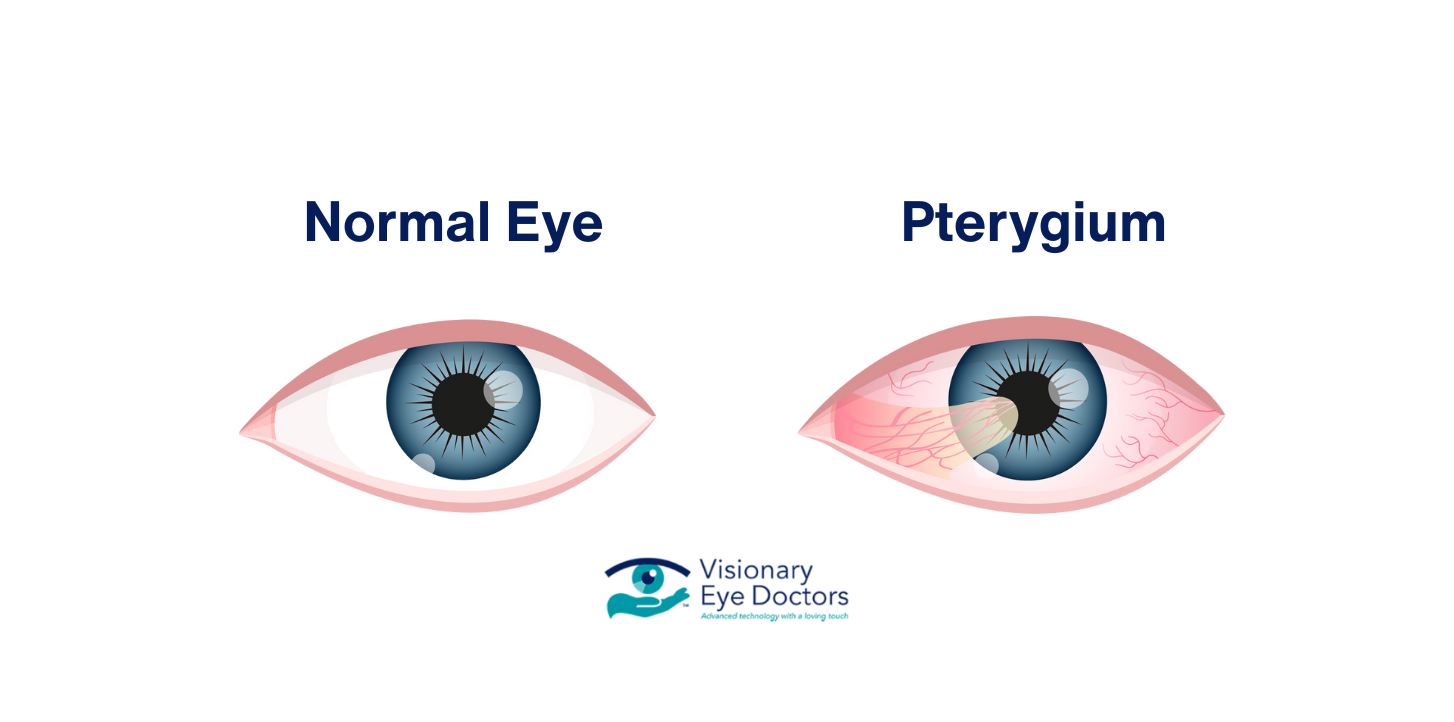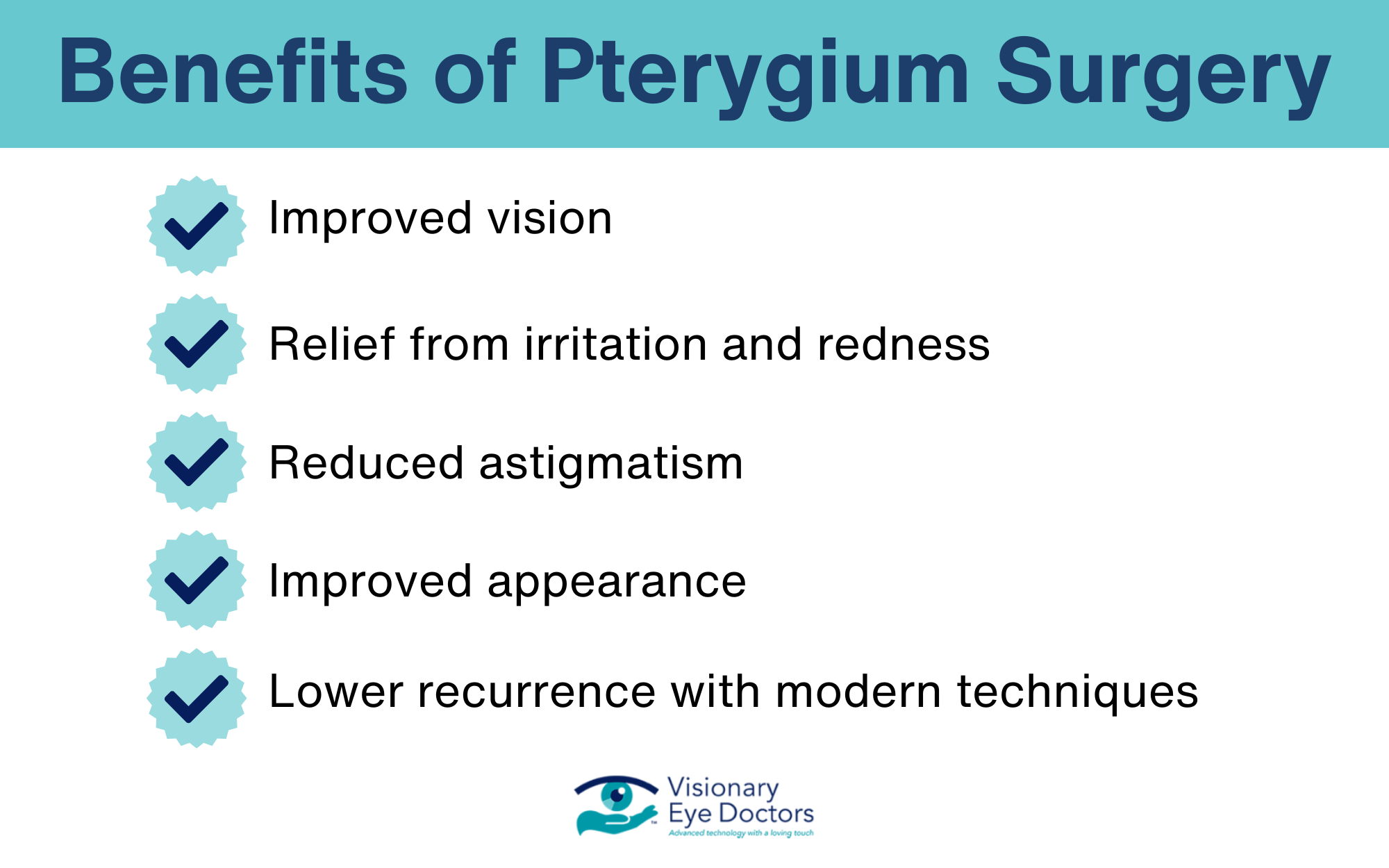Is Pterygium Surgery Right For You?
The Quick Answer: Pterygium surgery is right for you if the fleshy growth on your eye is causing vision problems, persistent discomfort, or cosmetic concerns that affect your daily life. Most patients experience excellent results with this safe procedure when performed by an experienced eye doctor.
A pterygium, sometimes called “surfer’s eye,” is an abnormal growth of clear tissue that develops on the white part of your eye and can spread across the cornea. While this eye condition is generally harmless, it can cause significant discomfort and vision issues when it grows large enough to interfere with your sight. Understanding when pterygium removal is necessary and what the surgical process involves helps you make an informed decision about your eye health.
This guide covers:
- When surgery becomes necessary
- Best candidates for surgery
- Surgery expectations
- Recovery and care
- Risks and benefits
- Questions for your doctor
What is a Pterygium, and When Does It Require Surgery?
Pterygium: A fleshy growth that starts on the conjunctiva (the clear membrane covering the white of your eye) and can gradually extend onto the cornea.
- This abnormal tissue growth typically develops due to prolonged exposure to ultraviolet light, dust, and wind, which is why it’s commonly seen in people who spend significant time outdoors.
The condition often begins as a small, barely noticeable patch but can progressively grow larger over time.

Early-stage symptoms of a primary pterygium include:
- Mild irritation that can be managed with artificial tears
- Discomfort relieved by protective eyewear
However, pterygium surgery becomes necessary when conservative treatments fail to provide relief and the growth begins to interfere with your vision or quality of life. Key indicators that surgical removal may be needed include:
- Vision problems, such as blurred sight or astigmatism, are caused by the growth pulling on the cornea. When the pterygium grows large enough to cover part of your pupil, it can significantly affect your visual acuity and daily activities like reading or driving.
- Persistent discomfort, including redness, irritation, and a constant feeling that something is stuck in your eye. These symptoms often worsen in windy or dusty environments and may not improve with eye drops or other conservative treatments.
Cosmetic concerns affecting your confidence and social interactions. While pterygium surgery isn’t typically performed for cosmetic reasons alone, the appearance of a prominent fleshy growth can cause significant distress for some patients.
Who Are the Best Candidates for Pterygium Surgery?
The best candidates for pterygium excision are patients whose symptoms significantly impact their daily lives despite trying conservative treatments. Your eye doctor will evaluate several factors to determine if surgical removal is appropriate for your situation.

Vision Impairment
Vision-impaired patients are the strongest candidates for surgery. When the abnormal growth begins affecting your visual acuity or causes double vision, pterygium removal can restore clear sight and prevent further complications. The procedure is particularly beneficial for those whose pterygium has grown large enough to induce astigmatism or other refractive errors.
Persistent Discomfort
Those with persistent discomfort that doesn’t respond to artificial tears, contact lens adjustments, or other conservative measures also benefit significantly from surgical treatment. If you find yourself constantly bothered by redness, irritation, or the sensation of having something in your eye, surgery can provide lasting relief.
Cosmetic Concerns
Patients concerned about the cosmetic appearance of their pterygium may also be good candidates, especially when the growth is large and visible. While this procedure isn’t performed solely for cosmetic reasons, the improved appearance following successful pterygium surgery often provides substantial psychological benefits.
Your healthcare provider will also consider factors like your overall eye health, age, and lifestyle when determining candidacy. Patients who can commit to following post-operative care instructions and attending follow-up appointments typically achieve the best outcomes.
What to Expect: The Pterygium Surgery Process
Understanding the surgical process helps reduce anxiety and ensures you’re well-prepared for your procedure. Pterygium removal is typically performed as an outpatient procedure using local anesthesia, allowing you to return home the same day.
Step 1: Pre-Operative Consultation
During your pre-operative consultation, your eye doctor will perform a thorough examination to assess the size and location of your pterygium. This evaluation helps determine the best surgical technique for your specific case. The surgeon will also discuss your medical history and any medications you’re taking to ensure the procedure is safe for you.
Step 2: Tissue Removal
The most common surgical technique involves carefully removing the abnormal tissue from your eye. Your surgeon will use precise instruments to excise the pterygium while preserving healthy surrounding tissue.
Step 3: Graft Placement
The exposed area is covered with a tissue graft. The conjunctival autograft method uses healthy tissue from another part of your eye, which significantly reduces the recurrence rate compared to older techniques. Some surgeons may use an amniotic membrane transplantation instead, placing processed amniotic membrane over the surgical site to promote healing and reduce inflammation.
Step 4: Securing the Graft
Your surgeon may apply mitomycin C, a medication that helps prevent the abnormal growth from returning. Modern surgical techniques often use fibrin glue or fibrin tissue adhesive instead of traditional sutures to secure the graft, which can improve comfort during the healing process.
Step 5: Recovery Instructions
The entire procedure typically takes 30-45 minutes, and you’ll be able to go home shortly after surgery with detailed post-operative instructions.

Recovery Timeline and Post-Operative Care
Your recovery period following pterygium surgery is crucial for achieving optimal results and preventing complications. Understanding what to expect during each phase of healing helps ensure a smooth recovery process.
- Day 1-2: The first 24-48 hours after your procedure are the most critical. You’ll likely experience some discomfort, tearing, and light sensitivity, which are normal parts of the healing process. Your eye doctor will prescribe specific eye drops to prevent infection and reduce inflammation. It’s essential to use these medications exactly as directed throughout your recovery time.
- Week 1: During the first week, you should avoid getting water in your eye while showering or washing your face. Most patients can return to desk work within a few days, but you’ll need to avoid strenuous activities, heavy lifting, and anything that could put pressure on your healing eye.
- Week 2: By week two, many patients notice significant improvement in comfort and vision. However, you should still avoid swimming, contact sports, and activities in dusty or windy environments. Your surgeon will typically schedule a follow-up appointment during this time to monitor your healing progress.
- Full Recovery: The complete healing process can take weeks to months. During this period, the graft tissue integrates with your natural eye tissue, and any initial redness or swelling gradually resolves. Most patients can resume all normal activities within 3-4 weeks, though your specific timeline may vary based on your healing response.
Throughout your recovery period, watch for signs of complications such as increasing pain, vision changes, or signs of infection. Contact your healthcare provider immediately if you experience any concerning symptoms.
Benefits of successful pterygium surgery include:
- Improved vision and comfort
- Dramatic relief from irritation, redness, and foreign body sensation
- Clearer sight and reduced astigmatism when the growth was affecting vision

Most patients find that the benefits far outweigh the risks, especially when the procedure is performed by an experienced surgeon using proven techniques. The improved quality of life, better vision, and freedom from constant eye irritation make this a highly successful treatment for appropriate candidates.
Making Your Decision: Questions to Ask Your Eye Doctor
Choosing the right time for pterygium surgery requires careful consideration and open communication with your eye doctor. Asking the right questions helps ensure you’re making the best decision for your specific situation.
Important questions to ask your surgeon:
- Which surgical approach do you recommend for my specific case?
- How do you handle potential complications during surgery?
- Are there alternative treatment options I haven’t tried yet?
- What should I expect during my recovery period?
- How can I better protect my eyes from UV light to prevent future problems?
You should also discuss the expected recovery time and how it might affect your work and lifestyle. If you have specific concerns about activities like sports or outdoor work, make sure your surgeon understands these priorities. Ask about the long-term outlook and what signs might indicate a need for additional treatment.
Expert Pterygium Care at Visionary Eye Doctors
Choosing an experienced eye surgeon significantly impacts your recovery time and outcomes from pterygium surgery. At Visionary Eye Doctors, our skilled surgeons use advanced surgical techniques to ensure optimal results and minimize the risk of recurrence.
Our detailed approach includes a detailed evaluation to determine the best treatment plan for your specific case, advanced surgical techniques including conjunctival autografting and amniotic membrane procedures, and thorough post-operative care with clear instructions for optimal healing.
Ready to learn more about pterygium surgery and how it can improve your vision and comfort? Contact Visionary Eye Doctors today to request a consultation and discover how our expertise can help you see more clearly and comfortably than ever.



